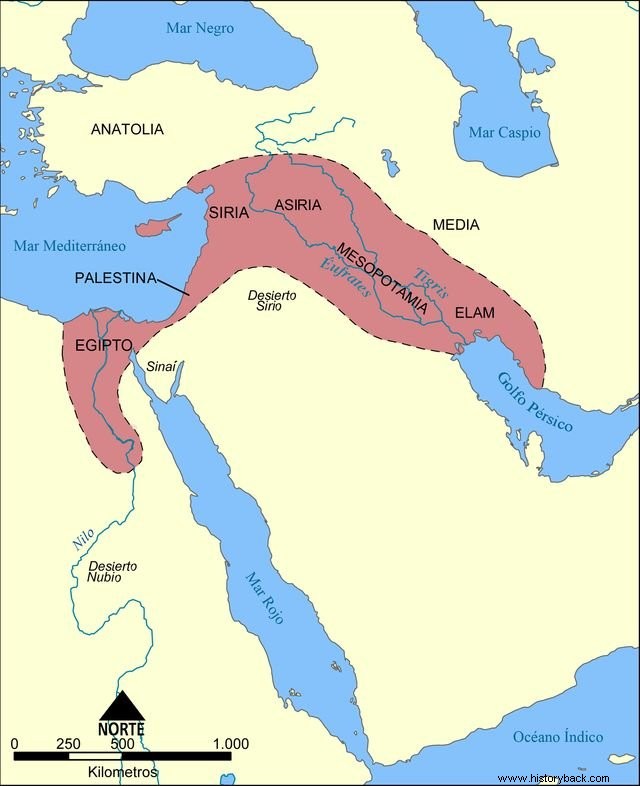The Fertile Crescent is called the “Cradle of Civilization ”, since several peoples of antiquity (around 10,000 BC) developed in this region, hence its great importance in the history of humanity.
Location
 Map of the Fertile Crescent region
Map of the Fertile Crescent region
Corresponds to a region of the Middle East, with approximately 500 thousand km 2 of extension. It is located between Jordan, Lebanon, Syria, Egypt, Israel, Palestine, Iran, Iraq and part of Turkey.
It harbors great rivers such as the Nile, Tigris, Euphrates and Jordan. All of them made agriculture the main means of subsistence of the first great civilizations of eastern antiquity.
History:Summary
In addition to agriculture, an activity that fixed the human race to the detriment of nomadism, the Fertile Crescent stood out for the social, political, economic and cultural development of civilizations.
This has been since the emergence of cities, commerce, the alphabet (writing) and various tools created by man.
It was in this context that ancient civilizations became “sedentary”, that is, they started to settle in places and produce their own food.
This “sedentary lifestyle” was the necessary fulcrum for the growth of cities and, above all, for the development of ancient civilizations. Scientific development, technological progress and other livelihoods stand out.
Many methods of agriculture were used, such as the irrigation and drainage systems of swamps, which were expanding and providing the greatest development of civilizations.
Many historians point to the Fertile Crescent region as the precursor to the formation of great civilizations, called Empires.
Currently, the Fertile Crescent has been suffering from several environmental impacts. Many of the regions, which were once considered fertile, have now been taken over by desertification, thus becoming unproductive and infertile areas.
Meaning
The “Fertile Crescent” or “Fertile Half Moon” gets its name since the region, if looked at on the map, has the shape of a crescent moon. That is, a semicircle that, by extension, received the adjective “fertile”.
The floods of the rivers that surround it, produced valleys with fertile soils (natural fertilizer rich in nutrients) favorable for the practice of agriculture.
The term “Fertile Crescent” was first used by the American archaeologist and historian James Henry Breasted (1865-1935).
It was quoted in his work “Ancient Records of Egypt ” (in English:“Ancient Records of Egypt ”), published in 1906. The author's idea was to designate the areas of Mesopotamia and Egypt.
Civilizations
Many civilizations developed in the region called the Fertile Crescent, for example, the Sumerians, Persians, Assyrians, Akkadians, Egyptians, Hebrews, Phoenicians, Mesopotamians, among others.
Of these two great civilizations stand out:the Egyptian civilization, which emerged on the banks of the Nile River, and the Mesopotamian civilization, developed on the banks of the Tigris and Euphrates rivers.
Read Also :
- Antiquity
- People of Mesopotamia
- Babylonian Empire
- Middle East
- Questions about Mesopotamia
